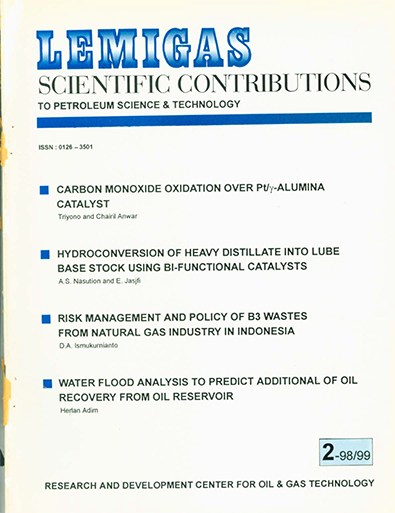Hydroconversion Of Heavy Distillate Into Lube Base Stock Using Bi-Functional Catalysts
DOI:
https://doi.org/10.29017/SCOG.21.2.956Keywords:
Hydroconversion, lube, CatalystsAbstract
Hydroconversion process replaces the furfural stage and dewaxing part of conventional processs of lube base stock production. To study the ability of this hydroconversion process to weed low viscosity index component out of heavy distillate fraction to produce high viscosity index lube base stock, an experiment has been carried out on the hydroconversion of three feedstock types, I,e,: non-paraffinic vacuum distillate (NPVD), paraffinic vacuum distillate (PVD) and paraffin-wax (WAX), using three bifunctional catalysts having low, medium abd high acidities. The experiment was done at the following operating conditions: temperature from 380° to 420°C, pressure: 100 kg/cm² and H₂/HC ratio: 1000 L/L using a Catatest Unit operated in continuous system.
The experimental data shows that at 50% by wt. feedstock conversion, the yields and viscosity index of lube base stock product are 20.7% by wt. and 118; 25.5% by wt. and 136; and 29.5% by wt. and 164 for NPVD, PVD and high acidity bifunctional catalysts, respectively. By conventional process, PVD feedstock produces 10-15% by wt. lube base stock with viscosity index lube 90 to 100.
The high viscosity index of lube base stock product, obtained by hydroconversion process, suggest that a part of condensed aromatics is converted into naphthenes, which are then selectivity hydrocracked into single alkyl aromatics by both the metal site and acid site of the bifunctional catalysts. With medium and high acidity bifunctional catalysts, isomerization and cyclization of wax feedstock into isoparaffins and single ring alkyl-naphthene ring of vacuum distillate feedstock into single ring alkyl-aromatic is quite dominant with medium acidity catalyst.
References
Conradt, H.L, and Garwood, W.E., 1961, “The Mechanism of Hydrocrackingâ€, The 140th Meeting of Am. Chem. Soc., Chicago, paper No. 50, Sept.
Beuther, H., Me Kisley, J.B., and Flinn, R.A., 1967, “Catalyst Hydrocrackingâ€, Am. Chem. Soc. Chicago Meeting, Sept, 3-5, p.A75-A90.
Le Page, J.F., 1987, “Applied Heterogeneous Catalysis, Design, Manufacture, Use of Solid Catalystsâ€, Eds. Technip, Paris
Carruthers, J.O., Brinen, J.S., Komar, D.A., and Greenhouse, S., 1994, “Catalytic Hydroprocessing of Petroleum and Distillatesâ€, Oballa, M.C., and Shih. S.S., p. 179-199, Eds., Dekker, New York
Zakaria, J.A., Robson, R.J., Farrell, T.R., 1986, “All-Hydroprocessing Route for High-VI Lubesâ€, AICHE Spring National Meeting, New Orleans.
Nasution, A.S., 1984, “Influence of the Catalysts Acidity on the Hydrocracking of Minas Vacuum Distillate Into Middle Distillateâ€, 8th Internatinal Congress on Catalysts, Bonn, West Germany, July 2-6.
Ward, J.W., and Qader, S.A., 1975, “Hydrocracking and Hydrotreatingâ€, ACS, Symp. Sci. No. 20.
Downloads
Issue
Section
License
Copyright (c) 1970 SCIENTIFIC CONTRIBUTIONS OIL AND GAS (SCOG)

This work is licensed under a Creative Commons Attribution 4.0 International License.
Authors are free to Share — copy and redistribute the material in any medium or format for any purpose, even commercially Adapt — remix, transform, and build upon the material for any purpose, even commercially.
The licensor cannot revoke these freedoms as long as you follow the license terms, under the following terms Attribution — You must give appropriate credit , provide a link to the license, and indicate if changes were made . You may do so in any reasonable manner, but not in any way that suggests the licensor endorses you or your use.
No additional restrictions — You may not apply legal terms or technological measures that legally restrict others from doing anything the license permits.














